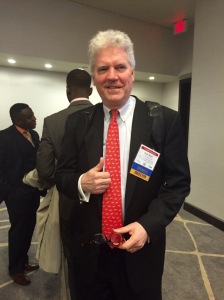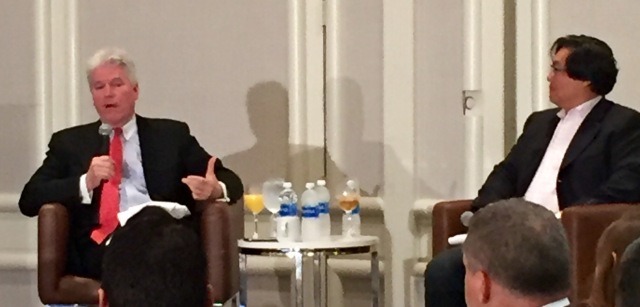
It’s 7:15 am and Mark Walsh, Associate Administrator, Office of Investment & Innovation for the Small Business Administration takes the photo op anyway.
Mark Walsh is the ultimate connector. He’s smart and his can-do confidence, experience and business/political connections and know-how have positioned him to invest billions of taxpayer dollars into a diverse cross-section of American innovators for the U.S. Small Business Administration (SBA). Mark is Associate Administrator of the SBA’s office of Investment and Innovation.
He recently told the capacity crowd at a Connectpreneur networking event in Bethesda, Maryland, how his fateful stint as chief executive founder at liberal talk-radio, network Air America Radio, led to his current adventure. It was there that he met Javier Saade who later called him for a recommendation for a job to help the SBA invest billions of tax dollars in a fund of funds (a portfolio of other investment funds) and startups. The SBA Associate Administrator for Investment, Special Advisor for Innovation, at the time Sean Greene, had been a sales executive Mark knew from AOL.
Mark recalls:
“That job sounded so good I thought I’d like to have it myself — but I promised to recommend Javier so I did and he got the job…He said he was building it up so it would be big enough for me and I fell for that sales job. When he was ready to move on he called me and said ‘It’s time to come meet the Administrator.'”
Welcome to the Government
In November 2015, President Obama appointed Mark to his current position, which was just the focused mission he needed. He says his title, Associate Administrator, Office of Investment and Innovation for the U.S. Small Business Administration, sounds a little “government-y … I fell in love with the job, I fell in love with the organization. It’s great to be here.”

Mark Walsh is comfortable in the spotlight since his early days as a TV newscaster in West Virginia. Tien Wong (Right), entrepreneur, community leader, and founder of the Connectpreneur networking event, jokes that he could simply ask Mark one question, sit back and Mark would fill the allotted time for the fireside chat. Says Mark about his job distributing SBA funding for innovation: “I’m really the luckiest, happiest guy I know.”
A Baltimore Boy & His Personality-Plus Mom
A Baltimore native, whose mother went into labor with him at an Orioles Game, Mark spent two years as a newscaster for a West Virginia television station before earning his MBA at Harvard Business School. He draws the audience in with the fun fact that his mother was the voice of the little boy who called out “More Parks Sausages, Mom — Please?” in a popular radio ad campaign. He finishes warming up the crowd by recounting his childhood memory:
“I would be sitting in the carpool and the ad would come on the radio and she would do it live for us in the car.”
Billions to Invest
Through the office of investment and innovation, he’s got $6.5 billion per year (refreshed) of tax dollars to invest in either fund of funds or in startups. One of his goals is to distribute all of the $4 billion in Small Business Investment Company (SBIC) authorization per year, not just part of it, as the office has hit $2.7 – $2.9 billion in the past 6-7 years. He says he can’t tell you exactly why it is so difficult to give away, but “I’ve got theories.”
“When we get an application for debt, there is a whole lot of paperwork on the entrepreneur’s background. We have a sister agency called the F-B-I [pause for laughter]… You’d be amazed how many of those founders/partners conveniently forget that arrest senior year of college. Or,…” He says, about to add another example but reconsiders and says:
“We do have a layer of mandated investigation. It’s your money; we have to be prudent and proper. It does take more paperwork and it takes time. It’s at least six months before you can get a yes, and you do that on your own time.”
Identifying investment candidates that create jobs and advance much-needed research for the U.S. government at a low loss radio takes some doing. Mark points out that the office of investment and innovation distributes taxpayer dollars is a zero subsidy program. “We generate jobs, we have a low-loss ratio and generate a positive cash-flow for the Department of the Treasury.”
Two main focuses of the annual multi-billion deployment he oversees are:
- Fund of funds = $4 billion a year of SBIC leveraged, cheap debt for 10 years at 3.5% interest to venture capital funds, PE funds, business development companies, and bank funds. Of particular interest are high impact funds, which spend 51 cents of every dollar supporting innovation in super rural or urban geographies; on businesses owned by women, Native Americans/minorities, wounded veterans and companies that pursue President Obama’s three major initiatives: Advanced Manufacturing, Clean Energy, and Education Software and Services. He observes: “These days impact funds are raising more and more money and their returns are at or in some cases exceeding market expectations.”
- Startups = $2.5 billion in cash, not debt, each year and a trip to the front of the line for a license, to thousands of entrepreneurs with technology that is matched against government research needs. Investment examples include iRobot, the Roomba robot vacuum built on technology that remembers surfaces covered when sweeping for landmines in the field; Epibone, which grows human bone; a replacement for Styrofoam packing pellets made of mushroom material; and a utensil that compensates for a shaking hand, a simple idea/company that Google just purchased.
“Go to SBIR.gov and you’ll see a long line of RFPs [Requests for Proposals] from U.S. government agencies. So if DOD [Department of Defense] says ‘I need a bench chemist or startup to have a way to weave Kevlar to be more bullet resistant,’ it’s a natural pathway for innovation and research for startups that want the government as an early customer.”
Collaborative Culture Skills
Mark spends a lot of time in what he calls “the political zone.” He was the Democratic Party’s first Chief Technical Advisor and Head of Internet operations for the Kerry Presidential Campaign in 2004. Like his colleagues, he will be prepared for the changes a new administration could bring, but assumes that at his level it will have months to prove himself.
In an effort to keep his dream job, Mark practices positive, politically correct speech — careful to add phrases like: “I joke because I love…” just in case some innocent humor could be misconstrued.
A straight shooter, who has been known to swear for good effect, Mark honed his diplomatic skills over about eight years as the Chairman of the Board of Directors of the Bipartisan Policy Center, a think tank (they fondly called a “do tank”) founded by four former heads of the US Senate: Tom Daschle, George Mitchell, Howard Baker, and Bob Dole.
Out of the Trenches, Onto the Road
In the Washington, DC, startup trenches, Mark was executive chairman of Homesnap.com, a residential “prosumer”real estate platform/app backed by fellow AOL alum via Revolution Ventures (September 2013 – November 2015) and CEO and co-founder of GeniusRocket (June 2007 – November 2015), crowd-sourced marketing for major brands and global nonprofits. During these years and earlier, beginning in January 2003, as Managing Partner of Ruxton Ventures, LLC, he served on a mixed bag of boards.
On the big corporate side, has been a division head and senior executive at technology and content companies, such as GEnie, AOL and HBO.
It wasn’t always sunshine and sausage. Mark lived through the March 2000 dot-com bubble collapse as CEO and Chairman of VerticalNet, which he took public on the NASDAQ in 1999. Terrible but instructive times.
In the quest to be “a really good fund to fund manager,”Mark aims to get more SBIR dollars into the marketplace for innovation and research that helps our government and helps commercialization as smoothly, efficiently, and in as technologically sophisticated way as possible. He says:
“If you look clownish in how you use technology, your customers and your clients will consider you as such. We’re getting a lot better at using technology to provide those funds to our partners and making sure it’s tracked.”
Mark and his team are taking their search for innovation and diversity on the road to regions such as Nashville, Pensacola, and Chattanooga. They would be considered unsuccessful if two-thirds of American capital goes into 25 zip codes, as it does currently. “It’s understandable, but not sustainable,” he says. To lighten up the room, he tears off on a riff:
“You’ve heard of Steve Case’s ‘Rise of the Rest’ bus tour? We have a bus, it’s a cheaper bus, it’s a government bus…it’s actually not a bus, we hitch hike, just so you know. If anyone is riding to Louisville after the event, I’ll be out in front of the hotel.”
Right now, there’s no place else Mark Walsh would rather be. The money to support innovation and job creation, the impact on diversity in all its forms, and the partnerships with government agencies add up to a job he “loves and wants to stick around and keep doing.”
